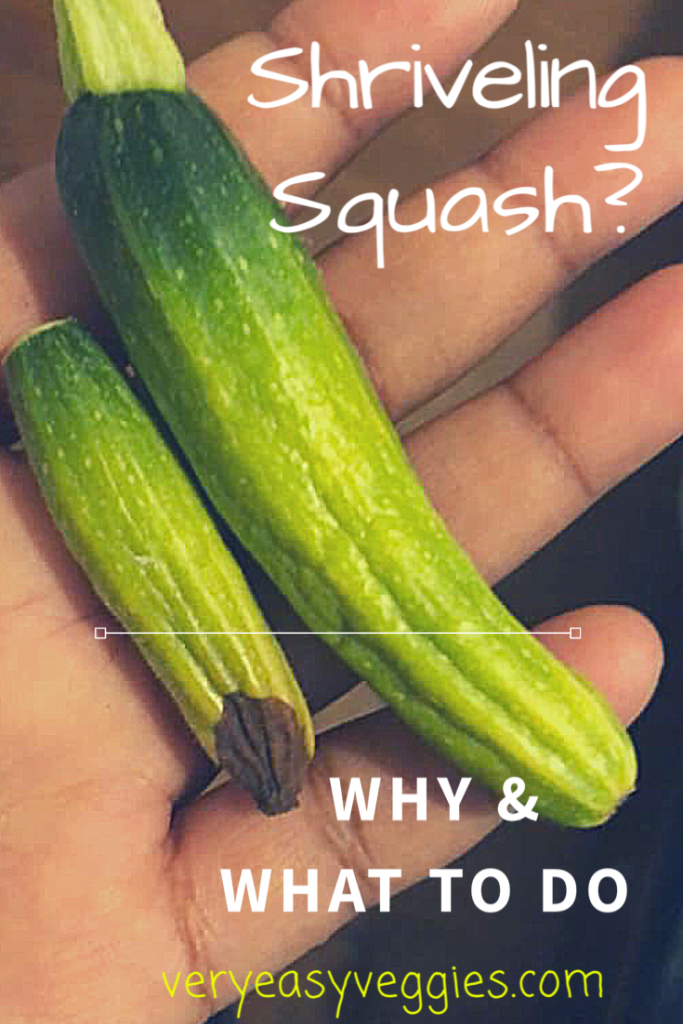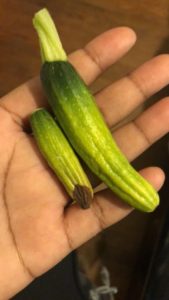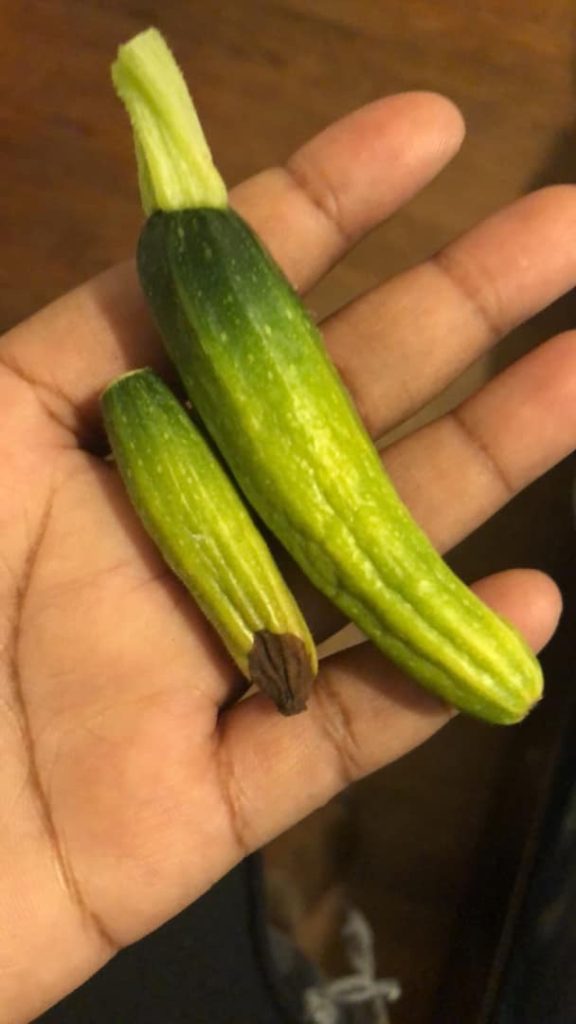Ever felt the excitement of watching your first squash start to develop, only to be disappointed when it quickly becomes wrinkled or starts rotting on the vine? The good news is that the problem may be easier to fix than you think.
Read on to find out which of these problems and solutions may be your answer! This post contains affiliate links for your convenience.

Is it pollination?
Many people may quickly assume that a shriveling squash or zucchini means that the flower wasn’t properly pollinated by bees. But before you get out a Q-tip to try pollinating yourself, you should know that this is not always the problem. It does happen sometimes, of course. But unless you haven’t seen any bees or butterflies in your garden, you probably don’t need to worry about hand-pollinating. In some cases you can try pruning away some extra leaves to make sure pollinators can reach the flowers.
If you have large healthy plants that produce mostly shriveled squash, and no other options here work, you can try hand-pollinating. Use a cotton swab to spread the pollen from male flowers (very skinny stem) to the female flowers (you will see a tiny squash forming below them).

It’s Too Early
Small shriveled squash at the very beginning of the season or occasionally during normal production are actually common. If your plants are still small or it’s early in the season, it’s nothing to worry about when the first few squash shrivel instead of growing. Simply pick them off and wait for the next ones to develop. If this keeps happening without any good ones forming, or your plants are very small, try out the next step.
If you only see flowers dropping off, this is also normal and they are most likely the male flowers, not the squash flowers.
The Plants Aren’t Strong Enough
Zucchini and squash plants are known for growing large, fast, and producing a lot! Not surprisingly, they are also “heavy feeders,” meaning they need a lot of nutrients from the soil to grow. Before a plant can produce a good crop for you, it needs to be large enough to support the “fruit.”
Take a look at your squash plant. Does it look big and bushy, with lots of good-sized leaves and thick stems? Or is the vine getting thinner and thinner as it grows? If your plants are small and growing slowly, shriveling squash probably means the plants are not yet strong enough to support them. In this case, the plants may need a boost of plant food, or you may not have rich enough soil. For help choosing the best soil for your garden, read this post.
Give your squash plants an early boost with a fertilizer that contains nitrogen, so they can grow strong to support good production. Read this post for help choosing fertilizer, or use one of the options below. Make sure you follow the directions on the fertilizer and don’t use too much either.
This organic based liquid fertilizer from Home Depot is my personal favorite for a quick boost and easy application.
Blossom End Rot / Overwatering
Blossom end rot is a very common problem in lots of gardens, with lots of different veggies. If you’ve seen tomatoes or peppers with dark spots forming where their flower was, this is blossom end rot. For squash, you may see black or brown at one end of the squash (the blossom end) or you may just notice that the blossom end is skinnier or softer.
A common misconception is that adding calcium to the soil will solve this problem. There is sometimes a link between calcium deficiency and blossom end rot, so a little extra calcium in the soil may help. Usually, though, this is not the main cause of the problem.
The most common reason for blossom end rot is too much water. If you’ve had a lot of rain recently, or if you’ve been letting your garden dry out and then drenching it, this is definitely your problem.
Vegetables grow best with consistent, even, moisture levels. In my drier climate, I find that the best way to accomplish this is using a hose timer. (Connected to a soaker hose, it saves me so much time too!). You can see the ones I use below and read more about my setup here. If your climate is just very wet, consider using raised beds and adding perlite to help drainage, or try to find a way to cover or protect them from excess water around the roots. Or as many gardeners do, wait it out and hope for better weather!
Bug Problems
I have not personally had this issue, but sometimes insect pests like squash vine borers can cause squash to rot. If you’d like some natural & organic insect control (that actually works!) read this post for some options. For squash vine borers, spinosad is probably your best organic option (click the photos below).


Did this help you? Subscribe by email for more simple solutions gardening tips for beginners, or get all the answers to beginner questions in my ebook below!
Which squash problem are you dealing with? Let me know in the comments.



Can a large number of ants contribute to this in any way?
Ooh, good question. I would say it could, in a few possible ways. First, if the ant colony is weakening the plant as a whole either by taking up residence around the roots or causing disease or weakness to the foliage, or perhaps in some cases the ants could be eating at the young zucchini or even keeping away pollinators. My preferred way to deal with ants is with an ant bait like terro, however neem or diatomaceous earth might help repel them.
Is there a way I can pollinate, since I don’t have any bees on the salt flats?
yes, it is possible to pollinate them yourself by taking a q tip or small paintbrush to collect pollen from the fresh male flowers (skinny stem) and applying them to the center part of the female flowers (female flowers have a thick stem that will become the zucchini/squash).
my squash plants are vigorous and strong, so, small plants causing squash shriveling is not the cause. Should I go ahead and feed the plants anyway, though that is not a recommendation in the above article. Thanks if you can help.
If they are strong and green, probably the only fertilizer they might need is one that is highest in the “middle number” phosphorus to promote “fruit growth.” otherwise perhaps pollination or watering could be an issue or maybe it’s just early season! hope they’re fruiting well now!
Pingback: 16 Easy To Grow Vegetables For Beginning Gardeners - NatureZedge